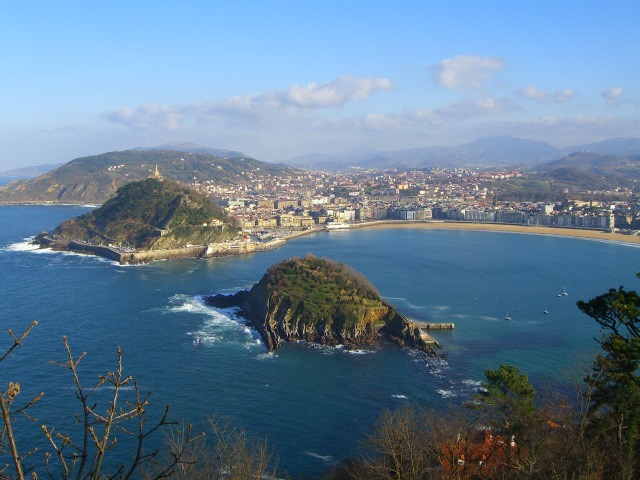Ensconced on the Atlantic Ocean’s Bay of Biscay, roughly halfway across the top of Spain, Euskadi (the Basque name for the Basque country) is a land of rolling hills and greenery. But balancing its bucolic charms are three urban gems that happen to be the capitals of its three provinces.

Astride the Nervión River, Vizcaya’s capital Bilbao is of course the best known of the three, thanks to the metamorphosis it’s undergone since the late 1990s, as local ironworks and other heavy industries faded and a cultural renaissance and wave of urban renewal took hold. The most famous result was the futuristic Guggenheim art museum designed by Frank Gehry, but other institutions came into being, too, such as the Alhóndiga Bilbao, a cultural centre co-designed by Philippe Starck and set in a handsome 1909 warehouse. The historic downtown got a long overdue makeover, too, making it a pleasure to stroll the narrow lanes full of packed bars; visit the Gothic Santiago Cathedral; enjoy a drink in a café in neoclassical Plaza Nueva; and browse the historic covered food market, the Mercado de la Ribera.
The city’s main thoroughfare, the Gran Vía, shows off the prosperous Bilbao of the turn of the 20th century, while the 21st is admirable represented by the 41-station Metro designed by the firm of Norman Foster, and highrises like the Isozaki Atea, by the firm of the eponymous Japanese architect – examples of what locals themselves wryly dub “bilbainadas”, referring to their city’s propensity to chase after the latest thing.

Then there’s San Sebastián (Donostia in Basque), which dates back to the 12th century but gained prominence at the end of the 19th when Queen María Cristina brought it into fashion among the Spanish (and to some extent the European) bourgeoisie as a summer resort. The old quarter, with the neo-Gothic Cathedral of the Good Shepherd, the Miramar Palace, and La Concha Beach are simply marvellous. The craggy beauty of Santa Clara island offshore and Mount Urgull complete the scenic picture.
On the shores of the bay, Eduardo Chillida’s triple sculpture “Comb of the Winds” always attracts visitors, who love the pressurised gushes of wind and salt water that fly out of openings in the floor. La Zurriola Beach is perfect for surfing (a sport with a lot of enthusiasts hereabouts), as well as the site of the Kursaal, a performance space and convention centre designed by architect Rafael Moneo, site of numerous glamorous events, foremost among them one of Europe’s top cinema fests, the San Sebastián Film Festival.
The third city in our tasty trio, Vitoria-Gasteiz, is the least well known, despite being the capital not just of Álava province but also of all Euskadi. Yet it shouldn’t be passed over, certified as one of the most liveable cities in Spain for its quality of life, green spaces, and green philosophy.
Its historic architecture is an astonishing mosaic of Renaissance-era manses, Romanesque and Gothic churches, the old city wall, and a pair of fortresses. In the Plaza of the White Virgin, with its characteristic white balconies, you’ll feel the pulse of the city. Behind it is the Cathedral of Santa Maria (inspiration for key aspects of Welsh bestseller author Ken Follett’s 2007 work World Without End). The arches herald the transition from the medieval quarter to the (relatively) newer parts of the historic centre, with Fueros Plaza, La Florida Park, and the elegant 19th-century zone known as the ensanche (one particularly striking landmark here being the Edificio Ópera).
Finally, if you make it to any or all of these cities, let me leave you with one word not to forget: pintxos (aka pinchos). These are a kind of tapa consisting of a meat, fish, or potato omelette resting skewered with a toothpick atop a slice of baguette. They can be found in pubs and taverns all over the place, and they are, to put it mildly, addictive. Don’t say we didn’t warn you. 🙂
images | Jean-Pierre Dalbéra, Mikelo, Mikelcg


